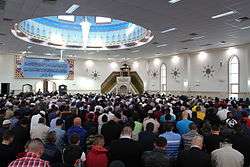Auburn Gallipoli Mosque
| Auburn Gallipoli Mosque | |
|---|---|
|
Auburn Gallipoli Mosque | |
| Basic information | |
| Location | Auburn (Sydney), New South Wales, Australia |
| Affiliation | Sunni Islam |
| Website | www.gallipolimosque.org.au/ |
| Architectural description | |
| Architectural type | Mosque |
| Architectural style | Classical Ottoman[1] |
| Completed | 28 November 1999[1] |
| Construction cost | A$6 million[1] |
| Specifications | |
| Dome(s) | 1 |
| Minaret(s) | 2 |
|
Part of a series on |
| History |
|
Early history |
| Mosques |
|
List of mosques |
| Organisations |
|
Islamic organisations in Australia |
| Groups |
|
Afghan • Albanian • Arab • Bangladeshi |
| Events |
| People |
| Prominent Australian Muslims Ibrahim Abu Mohamed |
The Auburn Gallipoli Mosque is an Ottoman-style mosque in Auburn, a suburb of Sydney, New South Wales, Australia. More than 500 worshippers attend every day and around 2000 worshippers attend the weekly special Friday prayer at the Auburn Gallipoli Mosque and is primarily used by Turkish Australians.[2]
Significance and history
The mosque's name invokes the legacy of the Gallipoli Campaign during World War I, which played a pivotal role in the history of both Australia and the Republic of Turkey. According to mosque officials, the name is meant to signify "the shared legacy of the Australian society and the main community behind the construction of the mosque, the Australian Turkish Muslim Community."[1]
The first mosque on the present mosque site was opened for worship on 3 November 1979. It was a house with internal walls removed to generate open space. The construction of the present mosque structure began in 1986. Its construction and external finishes were completed and officially opened on 28 November 1999, twenty years after the first opening.
See also
References
- 1 2 3 4 "History of the Auburn Gallipoli Mosque". Auburn Gallipoli Mosque. Archived from the original on February 16, 2011. Retrieved 27 March 2012.
- ↑ Tovey, Josephine (24 April 2010). "Turkish mosque joins honour roll of Australian heritage buildings". The Sydney Morning Herald. Retrieved 13 July 2011.
